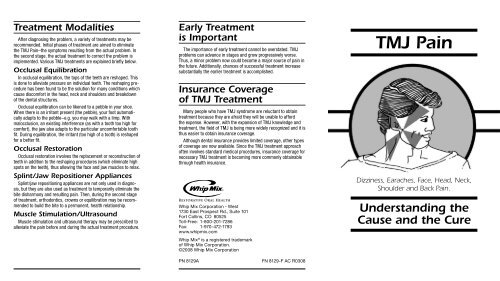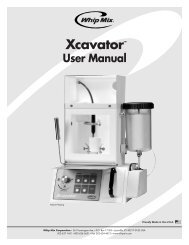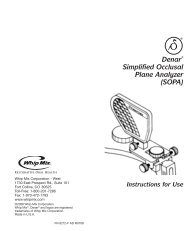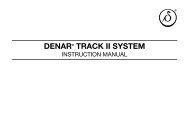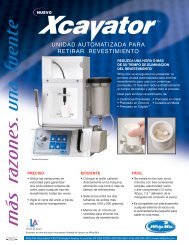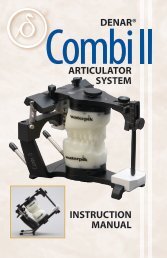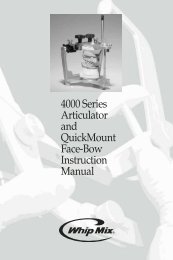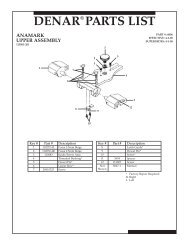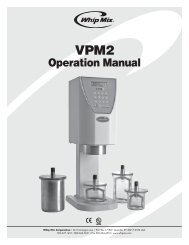TMJ Tutor Instructions - Whip Mix
TMJ Tutor Instructions - Whip Mix
TMJ Tutor Instructions - Whip Mix
You also want an ePaper? Increase the reach of your titles
YUMPU automatically turns print PDFs into web optimized ePapers that Google loves.
Treatment ModalitiesAfter diagnosing the problem, a variety of treatments may berecommended. Initial phases of treatment are aimed to eliminatethe <strong>TMJ</strong> Pain–the symptoms resulting from the actual problem. Inthe second stage, the actual treatment to correct the problem isimplemented. Various <strong>TMJ</strong> treatments are explained briefly below.Occlusal EquilibrationIn occlusal equilibration, the tops of the teeth are reshaped. Thisis done to alleviate pressure on individual teeth. The reshaping procedurehas been found to be the solution for many conditions whichcause discomfort in the head, neck and shoulders and breakdownof the dental structures.Occlusal equilibration can be likened to a pebble in your shoe.When there is an irritant present (the pebble), your foot automaticallyadapts to the pebble–e.g. you may walk with a limp. Withmalocclusion, an existing interference (as with a tooth too high forcomfort), the jaw also adapts to the particular uncomfortable toothfit. During equilibration, the irritant (too high of a tooth) is reshapedfor a better fit.Occlusal RestorationOcclusal restoration involves the replacement or reconstruction ofteeth in addition to the reshaping procedures (which eliminate highspots on the teeth), thus allowing the face and jaw muscles to relax.Splint/Jaw Repositioner AppliancesSplint/jaw repositioning appliances are not only used in diagnosis,but they are also used as treatment to temporarily eliminate thebite disharmony and resulting pain. Then, during the second stageof treatment, orthodontics, crowns or equilibration may be recommendedto build the bite to a permanent, health relationship.Muscle Stimulation/UltrasoundMuscle stimulation and ultrasound therapy may be prescribed toalleviate the pain before and during the actual treatment procedure.Early Treatmentis ImportantThe importance of early treatment cannot be overstated. <strong>TMJ</strong>problems can advance in stages and grow progressively worse.Thus, a minor problem now could become a major source of pain inthe future. Additionally, chances of successful treatment increasesubstantially the earlier treatment is accomplished.Insurance Coverageof <strong>TMJ</strong> TreatmentMany people who have <strong>TMJ</strong> syndrome are reluctant to obtaintreatment because they are afraid they will be unable to affordthe expense. However, with the expansion of <strong>TMJ</strong> knowledge andtreatment, the field of <strong>TMJ</strong> is being more widely recognized and it isthus easier to obtain insurance coverage.Although dental insurance provides limited coverage, other typesof coverage are now available. Since the <strong>TMJ</strong> treatment approachoften involves standard medical procedures, insurance coverage fornecessary <strong>TMJ</strong> treatment is becoming more commonly obtainablethrough health insurance.<strong>Whip</strong> <strong>Mix</strong> Corporation - West1730 East Prospect Rd., Suite 101Fort Collins, CO 80525Toll-Free: 1-800-201-7286Fax: 1-970-472-1793www.whipmix.com<strong>Whip</strong> <strong>Mix</strong> ® is a registered trademarkof <strong>Whip</strong> <strong>Mix</strong> Corporation.©2008 <strong>Whip</strong> <strong>Mix</strong> Corporation<strong>TMJ</strong> PainDizziness, Earaches, Face, Head, Neck,Shoulder and Back Pain.Understanding theCause and the CurePN 8129AFN 8129-F AC R0308
<strong>TMJ</strong> DysfunctionMany people suffer from dizziness, earaches, face, head, neck,shoulder and back pain, without knowing the cause of their pain.Previously, many patients seeking medical cures for these typesof problems were told it was “all in their mind.” They would gofrom “specialist” to “specialist” seeking a cure. Then after years ofunsuccessful treatment, they learned to live with the pain, usuallywith the aid of over the counter drugs, mainly aspirin.Today, however, it is now known that a condition termed <strong>TMJ</strong>(temporomandibular joint) syndrome accounts for a large numberof these previously uncured and painful ailments. The above typesof pains are symptoms of the syndrome–not the problem itself.Correcting the problem rather than the symptom is at the heart of<strong>TMJ</strong> treatment.Today, with new knowledge and technology, dentists are ableto diagnose and treat <strong>TMJ</strong> problems which previously have beenoverlooked. Additionally, the medical profession is becoming moreaware of dentistry’s involvement and physicians are referringpatients to dentists knowledgeable in <strong>TMJ</strong> treatment.Malocclusion and theTemporomandibular JointYour jaw joint, which holds your lower jaw in place, is suspendedbeneath your skull by an intricate system of muscles and tendons.The jaw joints, also known as the temporomandibular joints (<strong>TMJ</strong>),are some of the most complex in the body. The jaw joint, surroundingmuscles, and the fit of your teeth are closely interrelated, eachaffecting the other as your make everyday jaw movements such asspeaking and chewing.The way your teeth fit together is called Occlusion. When yourteeth are not in proper relation to each other and to you jaw joints,the jaw automatically shifts to a new position in an attempt tocompensate for the misalignment of your teeth–a condition knownas malocclusion (teeth do not fit together properly).Ideal occlusion is whenthe teeth fit togetherin a comfortablerelationship and thereis no need for the jawto reposition itself inorder to avoid pain andmuscle discomfort.When malocclusion exists, even what looks like a good bite couldbe at the expense of putting pressure on other jaw joint areas asthe jaw shifts to accommodate the teeth. Symptoms of misalignedteeth may be clenching, grinding, premature tooth wear, stress onthe muscles and tendons, some of which may occur during sleep.Results of these symptoms are headaches, and muscular aches andpains in the face, neck, shoulders and back, dizziness, earaches,ring in the ears and many other problems.With malocclusion, inorder to achieve closureand avoid pain, the jawshifts to accommodatethe teeth causing stressin and around the jawjoint and muscles.In addition to these common conditions which often (but notalways) relate to malocclusion and cause pain in and around thetemporomandibular joint, there are other conditions which canaffect the function and comfort of this joint and the total bodyhealth. These conditions include disease, nutritional deficiencies(e.g. gout), tumors, trauma and infections.Diagnosing the ProblemBefore prescribing the proper treatment for your particularproblem, a variety of diagnostic procedures may be necessary. Aradiograph (x-ray) may be taken of your jaw joint. This provides aclear picture of your own particular <strong>TMJ</strong> anatomy and position ofthe various structures within the jaw joint. The visual radiograph isalso used as a means for detecting disease in the jaw joint.Jaw repositioners may be used. These appliances are worn for agiven period of time. The appliance is refined and adjusted until iteliminates the bite disharmony and pain. In this way, the bite needto be permanently altered until the problem is accurately diagnosedvia the splint and other procedures. Permanent treatment wouldthen be prescribed to duplicate the effects of the appliance, e.g.equilibration or occlusal adjustment, orthodontics or restorativeprocedures such as crowns.In order to study the relationship of the patient’s teeth and joints,it is necessary to see how the joints guide the jaw without interferencefrom the reflexes and muscles which are always accommodatingto the fit of the teeth. To do this a record is taken measuringthe relationship of the teeth to the jaw. Once this record of the jointguidance is taken, it can be reproduced on an instrument called anarticulator, which simulates your own particular jaw movementsand bite relationship. Then without interferences from reflexes andmuscles, the bite can be studied for disharmonies and other interferences.Necessary restorative procedures–crowns and bridgesmay be built outside of the mouth, analyzed on the articulator andlater positioned accurately in the mouth allowing proper fit andfunction.Using instrumentation such as this saves you time and discomfortas it eliminates the need to sit in the dental chair while the fit andfunction is being adjusted.


